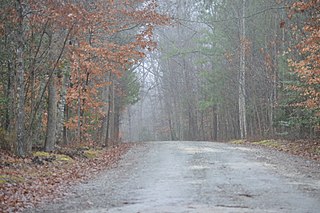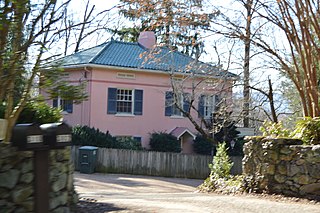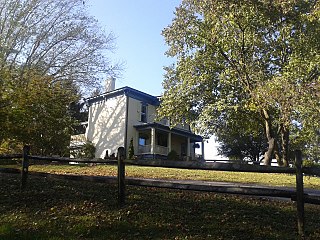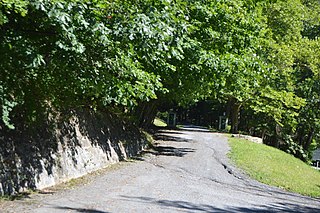
Marine Corps Base Quantico is a United States Marine Corps installation located near Triangle, Virginia, covering nearly 55,148 acres (86.169 sq mi) of southern Prince William County, Virginia, northern Stafford County, and southeastern Fauquier County. Used primarily for training purposes, MCB Quantico is known as the "Crossroads of the Marine Corps".

Burlington is a historic plantation house located near Aylett, King William County, Virginia. The main house is a two-part structure consisting of the Classical Revival-style main portion, erected in 1842, and a fragment of a Colonial-period frame dwelling serving as the rear ell. The main section is a two-story, stuccoed brick dwelling with a standing seam metal gable roof. The earlier portion is topped by a hipped roof. Also on the property are the contributing old smokehouse, an early framed barn, and a family cemetery surrounded by a brick wall.

The Arcola Slave Quarters were built circa 1800 on the grounds of the Lewis plantation at Arcola in Loudoun County, Virginia. The plantation house was replaced by a different house in the 1930s on the original foundation, but the slave quarters remain. The stone structure is a double-pen building built into an embankment downhill from the main house. The western end is older, with two connecting rooms and a cellar, accessible through a hole in the floor. The eastern end consists of two rooms, connected to the original wing by a breezeway. Each block has a central chimney with two hearths. The walls are stone rubble construction with timber roof construction. A loft, probably a later addition, has been created on the attic space. The floors are dirt, except for the room over the cellar, which is wood. The roof is asphalt roll roofing over plywood, but traces of the older wood shake roof remain. There are several window openings which do not appear to have been glazed, but rather shuttered.

Fleetwood Farm, also known as the Greenhill Plantation and Peggy's Green, is a Federal style house in Loudoun County, Virginia. The house is conjectured to have been built around 1775 by William Ellzey, a lawyer originally from Virginia's Tidewater region. The house is an unusual example of post-and-beam construction in a region where stone or brick construction is more usual.

Casa Maria is a historic estate located near Greenwood, Albemarle County, Virginia, United States. The main house was built 1921–1922 in the Spanish-Mediterranean style, with a two-story brick addition that dates from 1928, and was designed by architect William Lawrence Bottomley. The main house consists of two perpendicular, 2 1/2-story, stucco wings with a low-pitched hipped roof and low roof hidden by a parapet. It features an enclosed garden with stuccoed walls, arched entrances, and brick paving is located in the angle of the two wings. Also on the property are two Spanish style stuccoed servant's quarters with decorative metal grilles and tile roofs, and several smaller outbuildings. The gardens were designed by noted landscape architect Charles Gillette.

Estouteville is a historic home located near Powell Corner, Albemarle County, Virginia. The main house was begun in 1827, and consists of a two-story, seven-bay central block, 68 feet by 43 feet, with two 35 feet by 26 feet, three-bay, single-story wings. It is constructed of brick and is in the Roman Revival style. A Tuscan cornice embellishes the low hipped roofs of all three sections, each of which is surmounted by tall interior end chimneys. The interior plan is dominated by the large Great Hall, a 23-by-35-foot richly decorated room. Also on the property are a contributing kitchen / wash house; a square frame dairy ; a square, brick smokehouse, probably built in the mid-19th century, also covered with a pyramidal roof; and a frame slave quarters.

Santillane is a historic home located near Fincastle, Botetourt County, Virginia. It was built in 1795, and consists of a two-story high, three bay by four bay, main block with a one-story, rear kitchen wing. It is constructed of brick and is in the Greek Revival style. The house has a shallow hipped roof and tetrastyle two-story front portico dated to the early 20th century. Also on the property is a contributing stone spring house. The house stands on a tract purchased by Colonel George Hancock (1754–1820) in 1795. The kitchen wing may date to his period of ownership.

Yorkshire House is a historic home located at Warrenton, Fauquier County, Virginia. It was built in 1938–1939, and is a two-story, 13 bay, brick dwelling in the Modern Movement style. It features a low-pitched slate roof, a horizontal emphasis, a curved corner with continuous steel windows, a large glass block window, an elliptical bay window with steel casements and a foliated, geometric, metal balustrade on the rear balcony. Also on the property are the contributing brick and- stucco garage, a banked stone pump house, and a frame storage shed.

The Oaks, also known as Innes Hill, is a historic home and farm located near Warrenton, Fauquier County, Virginia. The house was built between 1931 and 1933, and consists of a 1 to 2 1/2-story, five bay, Classical Revival style main block with a four-part plan. The attached sections are a one-story pantry and kitchen wing and garage attached by a four bay arcade. The main block features a prominent two-story, four-bay, pedimented portico has four extraordinary fluted Tower of the Winds columns. Also on the property are the contributing Italianate style brick stable ; a brick smokehouse; and an agent's cottage, tile barn, corn house, spring house and summerhouse built between 1928 and 1930; garage with servants' quarters, greenhouse, log cabin, potato house, pump house, chicken house and field shed built between 1931 and 1945; the mansion landscape and scene of the 1881 duel; and a windmill. It was the site in September 1881, of the one of the last four duels in Virginia, prior to enactment of anti-duel legislation in 1882.

Waveland is a historic plantation house and farm located near Marshall, Fauquier County, Virginia. The mansion was built about 1835, and is a two-story, three bay by five bay, brick dwelling in the Greek Revival style. It has a front gable roof and sits on an English basement. A six-bay-wide, two bay-deep rear addition designed by noted English architect Edmund George Lind (1829–1909) was added in 1859, creating a "T"-plan dwelling. Also on the property are the contributing meat house, stuccoed frame farmhouse, cistern, stone spring house ruin, and stone slave quarters ruin.

Rock Hill Farm is a historic home and farm located near Bluemont, Loudoun County, Virginia. The original section of the house was built about 1797, and has undergone at least four additions and renovations about 1873, 1902, 1947, and 1990. It is two-story, stuccoed stone, Quaker plan, Federal style dwelling with a gable roof. Also on the property are the contributing two-story, wood-frame bank barn ; one-story, pyramidal-roofed, stucco-finished smokehouse ; a two-story, gable-roofed, stucco and frame garage ; one story, gable-roofed, wood-frame corncrib ; one-story, gable-roofed, wood-frame office/dairy ; a fieldstone run-in shed ; a one-story, gable roofed, wood-frame stable ; the remains of a formal boxwood garden ; several ca. 19th-century, dry-laid, fieldstone fences (contributing); and a cemetery.

Cleremont Farm is a historic home and farm located near Upperville, Loudoun County, Virginia. The original section of the house was built in two stages between about 1820 and 1835, and added onto subsequently in the 1870s. 1940s. and 1980s. It consists of a stone portion, a log portion, and a stone kitchen wing. It has a five bay, two-story, gable-roofed center section in the Federal style. A one-bay, one-story Colonial Revival-style pedimented entrance portico was built in the early 1940s. Also on the property are the contributing original 1 1/2-story, stuccoed stone dwelling (1761); a stone kitchen from the late 19th or early 20th century; a stuccoed frame tenant house built about 1940; a stone carriage mount; and a series of five stone walls.

Welfley–Shuler House is a historic home located near Shenandoah, Page County, Virginia.

Berry Hill is a historic home and farm complex located near Danville, Pittsylvania County, Virginia, United States. The main house was built in several sections during the 19th and early 20th century, taking its present form about 1910. The original section of the main house consists of a two-story, three-bay structure connected by a hyphen to a 1 1/2-story wing set perpendicular to the main block. Connected by a hyphen is a one-story, single-cell wing probably built in the 1840s. Enveloping the front wall and the hyphen of the original house is a large, two-story structure built about 1910 with a shallow gambrel roof with bell-cast eaves. Located on the property are a large assemblage of contributing outbuildings including the former kitchen/laundry, the "lumber shed," the smokehouse, the dairy, a small gable-roofed log cabin, a chicken house, a log slave house, log corn crib, and a log stable.

Montpelier is a historic plantation house located near Sperryville, Rappahannock County, Virginia. The main house was built about 1750, and is a two-story, 11 bay, stuccoed stone and brick dwelling with a side gable roof. It consists of a five-bay main block with north and south three bay wings. It features a two-story verandah stretching the entire length of the house with eight large provincial Tuscan order columns. The property also includes the contributing smokehouse, storage house, and a frame cabin. It was added to the National Register of Historic Places in 1973.

Meadow Grove Farm is a historic farm complex and national historic district located at Amissville, Rappahannock County, Virginia. It encompasses 13 contributing buildings and 5 contributing sites. The main house was constructed in four distinct building phases from about 1820 to 1965. The oldest section is a 1 1/2-story log structure, with a two-story Greek Revival style main block added about 1860. A two-story brick addition, built in 1965, replaced a two-story wing added in 1881. In addition to the main house the remaining contributing resources include a tenant house/slave quarters, a schoolhouse, a summer kitchen, a meat house, a machine shed, a blacksmith shop, a barn, a chicken coop, a chicken house, two granaries, and a corn crib; a cemetery, an icehouse ruin, two former sites of the present schoolhouse, and the original site of the log granary.

Recoleta, also known as Rothery, is a historic home located at Charlottesville, Virginia. It was built in 1940, and is a two- to three-story, "U"-shaped, Spanish Colonial Revival style dwelling. The house is constructed of stuccoed reinforced cinder block and has a red tile gable roof, arched openings, an exterior stair, a balcony, and steel-framed casement windows. The "U" contains a patio enclosed by a loggia with a garden front. Also on the property is a contributing garden enclosed by a cinder block wall built in 1946 that incorporates a fountain wall with a tile roof, circular lantern niches, and a patio. The house was built for University of Virginia music professor Harry Rogers Pratt and his wife, Agnes Edwards Rothery Pratt.

The Elms, also known as the P. D. Camp House, is a historic home located at Franklin, Virginia. It was built in 1898, as a 2 1/2-story, stuccoed brick eclectic dwelling with features of the Queen Anne and Colonial Revival styles. It has a rear brick ell. It consists of a hipped roof central block flanked by a pedimented gable end and a three-story turret with a conical roof. The roof is topped with original decorative iron cresting and the house has a one-story porch. The house was built by Paul D. Camp, founder of the Camp Manufacturing Company, and later the Union Camp Corporation.

La Riviere, also known as the William Ingles House, is a historic home located at Radford, Virginia. It was built in 1892–1893, and is a two-story Queen Anne house with a brick first story and a stuccoed frame second story. The house sits on rock-faced limestone blocks and has a slate-sheathed hipped roof. It features a three-story battlemented tower, a conservatory, and a curving wraparound porch. Also on the property are a contributing cook's house, garage, ice house, drive, and wall and gate.

Three Hills is a historic home located near Warm Springs, Bath County, Virginia. It was built in 1913, and is a 2 1/2-story, frame and stucco Italian Renaissance style dwelling. It consists of a central block with flanking two-story wings and rear additions. The house has a Colonial Revival style interior. The front facade features a single-story, flat-roofed portico. Also on the property are the contributing small formal boxwood garden, three frame and stucco, one-story cottages, and a stone and brick freestanding chimney. Three Hills was built by American novelist and women's rights advocate Mary Johnston (1870-1936), who lived and operated an inn there until her death. J. Ambler Johnston, a young architect, distant relative of the writer and one of the founding partners of the Carneal and Johnston architectural firm, designed the house.

























